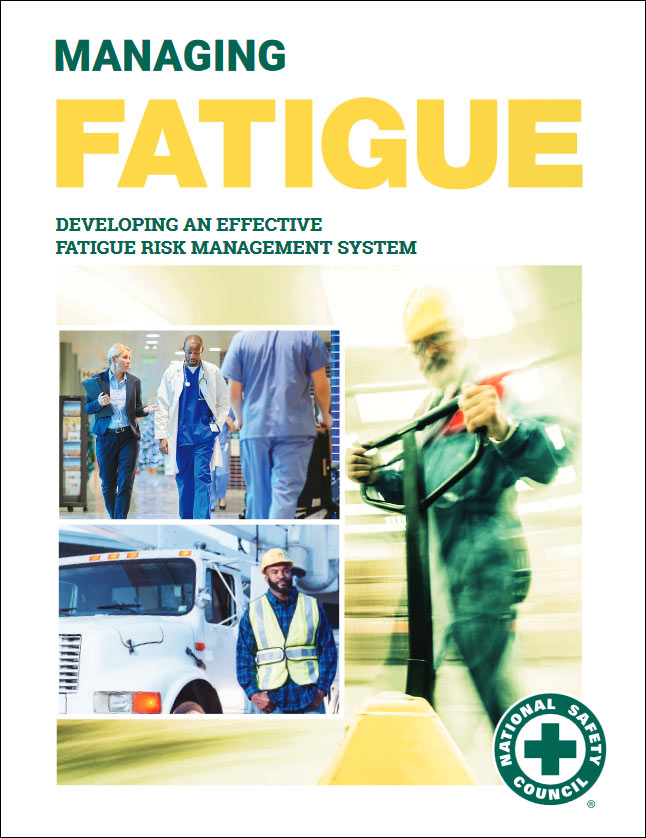Fatigue affects everyone at some time. Fatigue in the workplace decreases performance and increases the risk of accidents, injuries, and loss of life. Fatigue can be the result of insufficient sleep, prolonged physical or mental activity, and/or disruption of sleep because of irregular shift work.
Fatigued workers experience confusion, delayed reactions, and even fall asleep during their shifts. However, by taking some easy steps towards managing fatigue in the workplace – employers can save millions and even improve the quality of life for all employees.

What is fatigue?
Fatigue is a state of feeling very tired, exhausted, weary, or sleepy. Fatigue results from a lack of sleep and can be heightened from prolonged mental activity or long periods of stress or anxiety. Boring or repetitive tasks can also intensify feelings of fatigue.
Studies indicate that the risk of making mistakes at work increases significantly if workers sleep for less than the average (7.5–8.5 hours) or are awake for more than 17 consecutive hours. The effects of fatigue can reduce a worker’s:
- Ability to make decisions
- Ability to do complex planning
- Communication skills
- Productivity and performance
- Attention
- Ability to handle stress
- Reaction time
- Ability to recall details
- Ability to respond to changes in surroundings or information provided

Causes of fatigue
Fatigue is caused primarily by long hours of being awake. Other causes include extended shifts, shift rotations (days and nights), and irregular or disrupted sleep. Workplace factors, such as the following, can also increase feelings of fatigue:
- High temperatures
- High noise levels
- Dim lighting or poor visibility
- Work tasks that are long, repetitive, paced, difficult, boring, or monotonous
- Training provides details on OSHA, workplace hazards, workers’ legal rights, employer responsibilities, and how to file a complaint. Required by some states and companies in order to start employment.
- OSHA Authorized Provider
- DOL Plastic Card Shipped Within 2 Weeks
- Reg. Price: 10hr: $89 - 30hr: $189
- Enter Promo Code "osha15off" at Checkout
OSHA fatigue policy
While there is no specific OSHA policy on extended or unusual shifts, the Fair Labor Standards Act (FLSA) states that, “Any work over 40 hours in a 168 hour period is counted as overtime.” The FLSA applies to employees who work in interstate commerce, hospitals, schools, day workers, chauffeurs, cooks, housekeepers, and full-time babysitters.
Managing Fatigue
The National Safety Council’s paper “Managing Fatigue: Developing an Effective Fatigue Risk Management System” emphasizes that worker fatigue can have a negative impact on the workplace and can increase the risk of accidents and injuries at work.
According to the NSC, fatigued worker productivity costs employers $1,200 to $3,100 per employee annually. The risks for those who drive as part of their work are significant too – drivers are three times more likely to be in a crash if they are fatigued. Chronic sleep-deprivation can also lead to depression, obesity, cardiovascular disease and other illnesses.

Tips for getting a better sleep
People need at least 7.5 to 8.5 hours of sleep a day. Studies have found that most night-shift workers get less sleep per week than those who work day shifts. The quality of sleep during the day is not the same as during the night.
Here are some guidelines for improving quality of sleep:
- Go to bed and get up at the same time every day.
- Turn out the light immediately when going to bed.
- Don’t read or watch television in bed.
- Make your room as dark and quiet as possible.
- Some people sleep better in a cool room.
- Establish regular eating times.
- Avoid caffeine, tobacco, and alcohol, especially before bedtime.
- Exercise regularly.
Additional Resources
- United States Department of Labor: Minimum Paid Rest Period Requirements Under State Law for Adult Employees in Private Sector
- Federal Aviation Administration (FAA) — the FAA has produced a Fatigue Management Toolbox.
- United States Coast Guard (USCG) — Crew Endurance Management Systems
- National Response Team — Guidance for Managing Worker Fatigue During Disaster Operations
- American Petroleum Institute (API) — Fatigue Risk Management System
- International Petroleum Industry Environmental Conservation Association (IPIECA) — Managing Fatigue in the Oil and Gas Industry
- American College of Occupational and Environmental Medicine (ACOEM) — Fatigue Risk Management in the Workplace


























